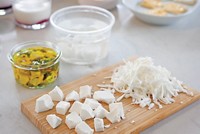Advertisement
Grab your lab coat. Let's get started
Welcome!
Welcome!
Create an account below to get 6 C&EN articles per month, receive newsletters and more - all free.
It seems this is your first time logging in online. Please enter the following information to continue.
As an ACS member you automatically get access to this site. All we need is few more details to create your reading experience.
Not you? Sign in with a different account.
Not you? Sign in with a different account.
ERROR 1
ERROR 1
ERROR 2
ERROR 2
ERROR 2
ERROR 2
ERROR 2
Password and Confirm password must match.
If you have an ACS member number, please enter it here so we can link this account to your membership. (optional)
ERROR 2
ACS values your privacy. By submitting your information, you are gaining access to C&EN and subscribing to our weekly newsletter. We use the information you provide to make your reading experience better, and we will never sell your data to third party members.
Food Ingredients
Replacing Trans Fat
New crops from Dow Chemical and DuPont target food makers looking for stable, heart-healthy oils
by Melody M. Bomgardner
March 12, 2012 | A version of this story appeared in Volume 90, Issue 11

Dow Chemical and DuPont are launching new seeds that promise oilseed crops with improved fatty acid profiles. The companies say the resulting vegetable oils will benefit both food makers and public health. The seeds—soybean from DuPont and canola and sunflower from Dow—yield crops with a higher proportion of monounsaturated oleic acid compared with nonenhanced versions.

The two companies developed the new oils as alternatives to partially hydrogenated vegetable oils, which contain unhealthy levels of trans fats. In January 2006, the Food & Drug Administration began requiring food manufacturers to list trans fat contents on product nutrition labels. The rule came after years of mounting evidence that the use of partially hydrogenated vegetable oils has negative heart-health effects due to the trans-fatty acids formed in their production. Food makers have struggled to replace trans-fat-containing oils and shortenings; if they embrace high-oleic oils from Dow and DuPont, the products will win a huge market.
The stories the two companies tell about their products are similar, with one notable exception. Whereas Dow achieved its Nexera high-oleic-acid canola and sunflower traits through plant breeding, DuPont’s improved Plenish soybean got that way through genetic engineering.
The companies are first eyeing the markets for frying and other liquid-oil applications. For applications such as baking that require solid shortening and may still involve some amount of trans fat, the new products will likely be blended with established trans fat replacements, namely palm oil and interesterified oils, which are processed vegetable oils that do not contain trans-fatty acids.
Crop acreage is ramping up, and in the next few years significant quantities of the new oils should hit the market, experts say. The opportunity is large: Roughly 22 billion lb of vegetable oils are used for food making in the U.S. annually.
“It’s too early to assess today’s market size for these next-generation products. They won’t be commercially launched until 2013. But yes, they will replace existing oils,” predicts Shahana Malik, food analyst at the consulting firm Nerac. “The food industry has moved into the change and is excited about it. With 40 food manufacturers experimenting with Plenish, it is clear they are willing to make this change.”
Replacing trans fat in food products is not easy. Trans-fatty acids are formed when vegetable oils are partially hydrogenated. And food makers love the qualities this transformation brings: Liquid oils become solid at room temperature, melting at higher temperatures such as when in the mouth or in the oven.
Partially hydrogenated vegetable oil has been part of the American diet since the early 1900s. Crisco, made from partially hydrogenated cottonseed oil, was launched in 1911. Until recently, partially hydrogenated oils were widely used in preparing restaurant foods such as french fries, as well as snack foods and baked goods. According to the Harvard School of Public Health, about 4 to 7% of the calories from fat consumed in the U.S. during the early 1990s were from trans fat. FDA and the Institute of Medicine now say consumption of trans fat should be “as low as possible.”
In partial hydrogenation, hydrogen is added to liquid oil under pressure and in the presence of a catalyst. The process breaks some carbon-carbon double bonds in the fatty acids of the oil and adds carbon-hydrogen bonds. Partial hydrogenation increases not only the oil’s melting point but also its shelf life. With fewer carbon-carbon double bonds, partially hydrogenated oil takes longer to become rancid than unhydrogenated vegetable oil. In the process of partial hydrogenation, however, a large number of the remaining double bonds isomerize and assume the unnatural trans configuration, instead of the naturally occurring cis configuration.
When first introduced, shortenings made with partially hydrogenated oils were thought to be better for health than tallow, lard, and butter. These animal-based shortenings contain high proportions of saturated fatty acids, which had long been known to increase the risk of heart disease. Partially hydrogenated oils even replaced liquid vegetable oils in packaged foods for longer shelf life.
By the 1980s and early 1990s, public health researchers had data showing that consumption of trans fat increased the risk of coronary heart disease by raising levels of low-density lipoprotein (LDL or bad) cholesterol and lowering levels of high-density lipoprotein (HDL or good) cholesterol in the blood. Since then, more health effects have been noted, including obesity and resistance to insulin.
Plant researchers were already on the case of replacing partially hydrogenated oils by the 1990s and got more time to achieve their goal because FDA took so long to institute trans fat labeling requirements, recalls Susan Knowlton, senior research manager and technical lead on DuPont’s Plenish team. “Much of the research for understanding how to modify fatty acids of oils had started already; it was pretty clear early on that the trans fat issue would become very significant and really impact the food industry,” Knowlton says.
Working with the genomes of oilseed crops enabled Dow and DuPont researchers to create oils with only naturally occurring fatty acids. But the challenge was to tilt the balance toward monounsaturated fatty acids. Polyunsaturated acids, while healthful, have multiple double bonds that make them oxidize much more quickly, leading to rancidity. And, of course, consumers have been taught to avoid saturated fats.
To change the fatty acid profile, molecular biologists and breeders had to alter a key biochemical pathway in the seed’s formation. Beginning with palmitic acid, a C16 saturated fatty acid, plant enzymes convert a portion of the fatty acids through a cascade that first adds two carbon atoms and then adds carbon-carbon double bonds at specific locations in the molecules. Some palmitic acid is converted to stearic acid, then oleic acid, linoleic acid, and finally linolenic acid. Palmitic and stearic acids are saturated, whereas oleic acid is monounsaturated. Linoleic acid and linolenic acid are both polyunsaturated.
The DuPont team engineered genes from soybean plants to block the formation of enzymes that continue the cascade downstream from oleic acid, resulting in an accumulation of the desirable monounsaturated acid. The genetically modified soybean produces oils that are also lower in saturated fat, Knowlton reports. “We can get rid of two bad actors. There is about 20% less saturated fat in Plenish compared to conventional soybean oil. Where traditional soy has 22% oleic acid, Plenish has over 75% oleic acid.”
At Dow, researchers used traditional and molecular breeding techniques, though they focused on the same pathway, according to David Dzisiak, commercial leader for grains and oils at Dow AgroSciences. “Our plant breeders used two key variations—one was very high in monounsaturates, and they found some experimental canola that has very low levels of linoleic acid. Through plant breeding we were able to cross those two.” Of the progeny, Dow found strains with high oleic acid and low linolenic acid.
The first target market for high-oleic oils is fried foods. When public health officials nixed trans fat, restaurants that had been using partially hydrogenated vegetable oils to fry foods went back to regular vegetable oil. With the switch came shorter usable life and residues from oxidized oil referred to in the industry as “gunk.” “Now, with the reduction in polyunsaturated fatty acids we have extended fry life by two to three times,” Knowles says. Not having to change oil every week, she adds, can result in a 40% cost savings.
In contrast, getting the oils into new, state-of-the-art shortenings for baked goods is still an area of experimentation. And health scientists are keen to see results. “The question is, of course, what the final fatty acid profile of these new fats will be. Therein lies the bugaboo,” says K. C. Hayes, a professor of nutrition in Brandeis University’s biology department. The new oils will need to be blended with solid fats to make a semisolid shortening.
Non-trans fat shortenings are made with either palm oil or interesterified vegetable oil. They contain some saturated fat but have good shelf stability. Palm oil contains more than 40% palmitic acid but is low in unstable polyunsaturated oils. It is semisolid at room temperature, but the solid and liquid components have different melting temperatures; thus it can be fractionated and recombined to make shortenings with different properties.
Interesterified vegetable oil is commonly used in baked goods and products such as stick margarine and newer versions of Crisco that have been reformulated to get rid of trans fat. An oil, commonly soybean, is fully hydrogenated to make saturated fatty acids, mostly stearic acid. Those saturated acids are stripped off the triglyceride backbone and combined with unsaturated fatty acids from regular soybean oil. The various fatty acids arrange themselves randomly on the three slots of the triglyceride backbone.
Of the random arrangements, wherever stearic acid appears in the second of the three slots, the result is a triglyceride that does not occur in nature. According to Hayes, recent human experiments suggest that interesterified oil is not metabolized easily. In one study, he says, “people’s glucose went up to prediabetic levels and insulin went down.”
Nerac’s Malik agrees that food makers now dependent on interesterified oils may find themselves having to reformulate once again. “People knowledgeable about palm oil versus interesterified oil picked palm oil” in a recent experiment that showed food labels to consumers, she points out.
Overall, Dow’s Dzisiak says, both food makers and consumers will benefit if high-oleic oils become part of the shortening blend. Instead of a shortening being 100% palm oil, it can be blended with an oleic-acid-rich oil to greatly reduce the saturated fat content and lengthen shelf life, he says.
DuPont’s Knowlton agrees. “You can blend in other oils to the amount you want. With a highly differentiated oil like Plenish, you can get the functionality you need with a blending process rather than with a chemical reaction.”






Join the conversation
Contact the reporter
Submit a Letter to the Editor for publication
Engage with us on Twitter